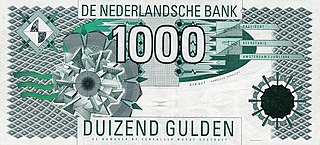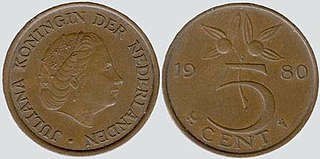The Five cent coin (commonly called Stuiver ) was a coin struck in the Kingdom of the Netherlands between 1818 and 2001. Twenty stuivers equalled a Dutch Guilder.
Contents




The Five cent coin (commonly called Stuiver ) was a coin struck in the Kingdom of the Netherlands between 1818 and 2001. Twenty stuivers equalled a Dutch Guilder.




| 5 cent 1818–1828 | 5 cent 1848 [1] -1887 | 5 cent 1907–1909 | 5 cent 1913–1940 | 5 cent 1941–1943 | 5 cent 1948–2001 | |
|---|---|---|---|---|---|---|
| Mass | 0.85 gram | 0.69 gram | 4.5 gram | 4.5 gram | 2.6 gram | 3.5 gram |
| Diameter | 15 mm | 12.5 mm | 18 mm | 21.3 mm (Square rounded corners) | 18 mm (Square rounded corners) | 21 mm |
| Thickness | ? mm | 0.76 mm | 1.8 mm | 1.5 mm | ? mm | 1.45 mm (1948) 1.44 mm (1950-1980) 1.45 mm (1982-2001) |
| Metal | Silver .569 | Silver .640 | Nickel | Copper/Nickel | Zinc | Bronze |
| Monarch | Mint | Material | Obverse | Reverse | Edge | Minting years |
|---|---|---|---|---|---|---|
| William I | Utrecht and Brussels | Silver | Crowned W between the mint year | Crowned Dutch coat of arms between value | Smooth with no edge lettering | 1818(U), 1819(U), 1822(U), 1825(B), 1826(B), 1827(U and B), 1828(B) |
| William II | Utrecht | Silver | Kings bust to the left | Value and mint year between two bonded oak branches | Reeded with no edge lettering | 1848 |
| William III | Utrecht | Silver | Kings bust to the right | Value and mint year between two bonded oak branches | Reeded with no edge lettering | 1850, 1853, 1855, 1859, 1862, 1863, 1868, 1869, 1876, 1879, 1887 |
| Wilhelmina | Utrecht | Copper/Nickel | A crown between two oak branches | Value in a wreath of two bonded orange branches | Smooth with no edge lettering | 1907–1909 |
| Wilhelmina | Utrecht | Copper/Nickel | Fruit bearing orange branches within a double edge | Value within a pearl edge | Smooth with no edge lettering | 1913, 1914, 1923, 1929, 1932–1934, 1936, 1938–1940, 1943 |
| German occupation coin | Utrecht | Zinc | Two Saxon horse heads under a sun | Value within a ring with a cereal ear to the right and nine waves to the left | Smooth with no edge lettering | 1941–1943 |
| Wilhelmina | Utrecht | Bronze | Queens head to the left | Value with a fruit bearing orange branch | Smooth with no edge lettering | 1948 |
| Juliana | Utrecht | Bronze | Queens head to the right | Value with a fruit bearing orange branch | Smooth with no edge lettering | 1950–1958, 1960–1967, 1969–1980 |
| Beatrix | Utrecht | Bronze | Half Queens head to the left | Value with interrupted rectangular planes | Smooth with no edge lettering | 1982–2001 |
| Discontinued due to introduction of the euro. | ||||||
Source [4]

The baht is the official currency of Thailand. It can be divided into 100 satang. The issuance of currency is the responsibility of the Bank of Thailand. SWIFT ranked the Thai baht as the 10th-most-frequently used world payment currency as of December 2023.

The Korean Won or Korean Empire won, was the official currency of the Korean Empire between 1900 and 1910. It was subdivided into 100 jeon.

The pula is the currency of Botswana. It has the ISO 4217 code BWP and is subdivided into 100 thebe. Pula literally means "rain" in Setswana, because rain is very scarce in Botswana—home to much of the Kalahari Desert—and therefore valuable and a blessing. The word also serves as the national motto of the country.

The guilder or florin was the currency of the Netherlands from 1434 until 2002, when it was replaced by the euro.

The stuiver was a coin used in the Netherlands, worth 1⁄20 Dutch Guilders. It was also minted on the Lower Rhine region and the Dutch colonies. The word can still refer to the 5 euro cent coin, which has almost exactly the same diameter and colour despite being over twice the value of the older coin.

The Bohemian and Moravian koruna, known as the Protectorate crown, was the currency of the Protectorate of Bohemia and Moravia between 1939 and 1945. It was subdivided into 100 haléřů.

The Netherlands Indies guilder was the unit of account of the Dutch East Indies from 1602 under the United East India Company, following Dutch practice first adopted in the 15th century. A variety of Dutch, Spanish and Asian coins were in official and common usage. After the collapse of the VOC at the end of the 18th century, control of the islands reverted to the Dutch government, which issued silver 'Netherlands Indies' guilder and fractional silver and copper coins until Indonesian independence in 1945.

The Swiss franc has been the currency of Liechtenstein since 1920. The Swiss franc is legal tender since Liechtenstein is in a customs and monetary union with Switzerland. The 1980 treaty between Switzerland and Liechtenstein allows Liechtenstein to mint limited amounts of Swiss francs with a Liechtenstein inscription, but only in the form of commemorative coins, and they are not allowed to issue banknotes.

The Artsakh dram was a monetary unit of the de facto independent Republic of Artsakh, which was dissolved on 1 January 2024 in the aftermath of Azerbaijani offensive in Nagorno-Karabakh. Despite being legal tender, it was not as widely used as the Armenian dram.
The half-cent coin was a Dutch coin used from 1818 to 1940. It was the smallest-denomination coin of the decimal Dutch guilder until its withdrawal from circulation after the German occupation of the Netherlands in 1940. It was nicknamed "Halfje", similar to the Kwartje.

The twenty-five cent was a coin worth a quarter of decimal Dutch guilder. It was used from the decimalisation of the currency in 1817 until the Netherlands adopted the euro as sole currency in 2002. The last minting was in 2001. The coin was the third-smallest denomination of the guilder when the currency was withdrawn, and the largest of a value less than one guilder.

A dubbeltje is a small former Dutch coin, originally made of silver, with a value of a tenth of a Dutch guilder. The 10-euro-cent coin is currently also called a dubbeltje in the Netherlands.
The Half guilder coin was a silver coin struck in the Kingdom of the Netherlands between 1818 and 1930. The obverse featured a portrait of the Dutch reigning King or Queen. On the reverse was a crowned Dutch coat of arms between the value. All coins were minted in Utrecht except the year 1829 and 1830 that were minted in Brussels.
The Two and a half cent coin was struck in the Kingdom of the Netherlands between 1818 and 1942. All coins were minted in Utrecht.
The Three guilder coin was a silver coin struck in the Kingdom of the Netherlands between 1817 and 1832.
The Indian paisa is a 1⁄100 (one-hundredth) subdivision of the Indian rupee. The paisa was first introduced on 1 April 1957 after decimalisation of the Indian rupee.

Although the vast majority of coins are round, coins are made in a variety of other shapes, including squares, diamonds, hexagons, heptagons, octagons, decagons, and dodecagons. They have also been struck with scalloped (wavy) edges, and with holes in the middle. Coins in the shape of polygons often have rounded edges or are Reuleaux polygons.

The Philippine twenty-centavo (20¢) coin was a denomination of the Philippine peso. The one-fifth (1/5) peso was introduced by both the Spaniards and the Americans during the colonial era of the Philippines. It was replaced by a banknote of the same denomination introduced alongside the establishment of the Central Bank of the Philippines in 1949 and it was replaced by the twenty-five centavo coin.
This is a list of commemorative coins issued by the Philippines. More info here.

The Great Qing Copper Coin, also known as the Qing Dynasty Copper Coin or Da-Qing Tongbi, officially the Tai-Ching-Ti-Kuo Copper Coin, refers to a series of copper machine-struck coins from the Qing dynasty produced from 1906 until the fall of the Qing dynasty in 1911. These coins were intended to replace the earlier cast cash coins and provincial coinages, but were welcomed to mixed receptions.